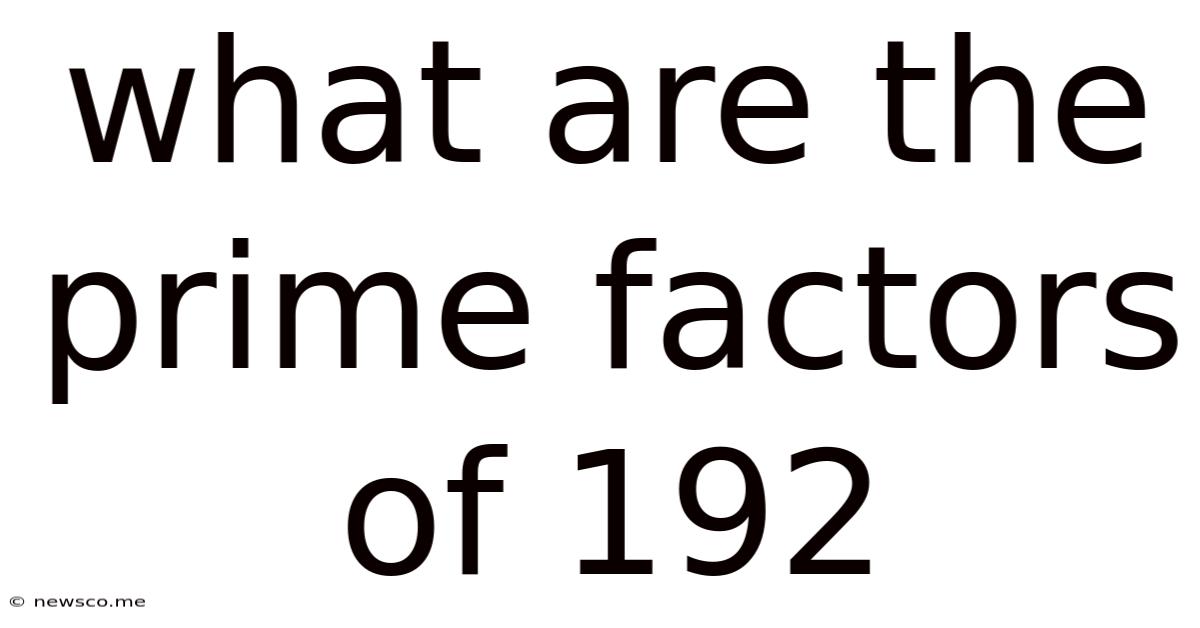What Are The Prime Factors Of 192
News Co
Mar 28, 2025 · 4 min read

Table of Contents
What are the Prime Factors of 192? A Deep Dive into Prime Factorization
Finding the prime factors of a number might seem like a simple mathematical exercise, but understanding the process reveals fundamental concepts in number theory and has practical applications in various fields like cryptography and computer science. This article will delve deep into determining the prime factors of 192, exploring the method, its implications, and the broader context of prime factorization.
Understanding Prime Numbers and Prime Factorization
Before we embark on finding the prime factors of 192, let's establish a solid foundation.
What is a Prime Number?
A prime number is a natural number greater than 1 that is not a product of two smaller natural numbers. In simpler terms, a prime number is only divisible by 1 and itself. The first few prime numbers are 2, 3, 5, 7, 11, 13, and so on. The number 1 is neither prime nor composite.
What is Prime Factorization?
Prime factorization (or integer factorization) is the process of finding the prime numbers that, when multiplied together, equal the original number. Every composite number (a number that is not prime) can be expressed as a unique product of prime numbers. This is known as the Fundamental Theorem of Arithmetic. This theorem is crucial because it guarantees that there is only one way to write a number as a product of its prime factors (excluding the order of the factors).
Finding the Prime Factors of 192: A Step-by-Step Approach
Now, let's tackle the task at hand: finding the prime factors of 192. We will use the method of repeated division by prime numbers.
-
Start with the smallest prime number, 2: 192 is an even number, so it's divisible by 2. 192 ÷ 2 = 96
-
Continue dividing by 2: 96 is also even. 96 ÷ 2 = 48
-
Repeat the process: 48 is even. 48 ÷ 2 = 24
-
Keep going: 24 is even. 24 ÷ 2 = 12
-
Still even: 12 is even. 12 ÷ 2 = 6
-
Another 2: 6 is even. 6 ÷ 2 = 3
-
Now we hit a prime number: 3 is a prime number. This means we've reached the end of our prime factorization.
Therefore, the prime factorization of 192 is 2 x 2 x 2 x 2 x 2 x 2 x 3, which can be written more concisely as 2⁶ x 3.
Visualizing Prime Factorization with a Factor Tree
Another helpful way to visualize the prime factorization process is using a factor tree.
192
/ \
2 96
/ \
2 48
/ \
2 24
/ \
2 12
/ \
2 6
/ \
2 3
The factor tree clearly shows the repeated division by 2 until we reach the prime number 3. All the numbers at the bottom of the tree are the prime factors of 192.
Applications of Prime Factorization
The seemingly simple process of prime factorization has surprisingly diverse applications across various fields:
Cryptography
Prime factorization is at the heart of many modern encryption algorithms. RSA encryption, one of the most widely used public-key cryptosystems, relies on the difficulty of factoring large numbers into their prime components. The security of RSA depends on the fact that while it's easy to multiply two large prime numbers, it's computationally extremely difficult to factor their product back into the original primes.
Computer Science
Prime factorization finds application in areas like hash table design and efficient data structures. Understanding prime numbers helps in optimizing algorithms and data storage.
Number Theory
Prime factorization forms the foundation of numerous theorems and concepts in number theory. It plays a vital role in understanding the properties of integers and their relationships.
Other Applications
Prime factorization has applications in various other domains including:
- Coding Theory: Used in error detection and correction.
- Digital Signal Processing: Utilized in efficient algorithms for signal processing.
- Mathematics Education: A crucial concept for developing number sense and algebraic thinking.
Beyond 192: Exploring Other Prime Factorizations
While we've focused on 192, the process of prime factorization can be applied to any composite number. Let's briefly look at some examples:
- Prime Factorization of 36: 2² x 3²
- Prime Factorization of 100: 2² x 5²
- Prime Factorization of 252: 2² x 3² x 7
The Significance of Unique Prime Factorization
The Fundamental Theorem of Arithmetic highlights the uniqueness of the prime factorization of any composite number. This means that no matter what method you use to factor a number, you will always arrive at the same set of prime factors. This uniqueness is a fundamental property of the integers and has far-reaching consequences in mathematics.
Conclusion: The Power of Prime Numbers
Understanding prime factors and the process of prime factorization provides a deeper understanding of the building blocks of numbers. From its fundamental role in number theory to its crucial applications in cryptography and computer science, the significance of prime factorization extends far beyond simple arithmetic. By mastering this concept, we unlock a deeper appreciation of the intricate structure and power of numbers. The relatively straightforward process of determining that the prime factors of 192 are 2⁶ x 3 exemplifies this fundamental concept and its broader implications within mathematics and technology. The seemingly simple exercise of factoring 192 unveils the vast and complex world of prime numbers and their significance in our understanding of the mathematical universe.
Latest Posts
Related Post
Thank you for visiting our website which covers about What Are The Prime Factors Of 192 . We hope the information provided has been useful to you. Feel free to contact us if you have any questions or need further assistance. See you next time and don't miss to bookmark.